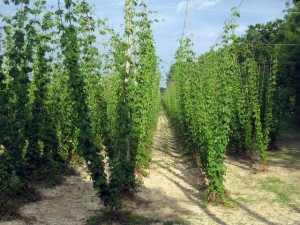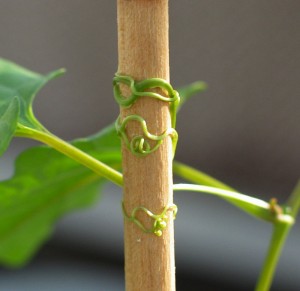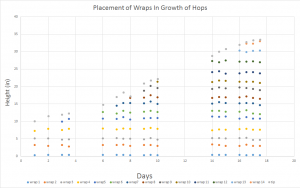Wrapped Around My Little Finger

http://www.geograph.org.uk/photo/1364147
Introduction/ Project Background: There are other plants besides Hop that do thigmotropic movement, such as Bindweed, Morning Glory, Periwinkle, Ivy, and a handful of others [2]. We found that plants “… use

Redvine (Brunnichia ovata) tendrils coil upon contact.
This image was released by the Agricultural Research Service, the research agency of the United States Department of Agriculture, with the ID D199-1 (next).
stem apices for twining and adherence to support structures” [5]. Thigmotropism is when a plant is stimulated by touch which can alter the plants growth [1]. The plants growth relies on this stimulus to detect objects around it to “feel” around so that it can do its wrapping movement that plants like Hop and Bindweed like to do [3]. The Hop being the only plant we ended up documenting because of unforeseen problems, is a herbaceous vine that lives between 10-20 years[4]. When the fruit grows and ripens, they are removed from the plant and used to make beer[4]. Understanding the way thigmotropic movement worked, we wanted to understand the movement of Hop specifically; how it curls around, growing up along objects.
their
Methods: We took pictures using a tripod from a set distance of 4 feet from the fence with one set of legs elongated so the camera was about 3 feet off the ground. We used an Olympus point and shoot camera. Photos were taken Monday through Friday twice a day at 12pm and 4pm for two and a half weeks. We created a video to understand the movement of the plants by compiling the pictures into a slideshow, we used Windows MovieMaker and Photoshop. to compile data about total height and the height of each wrap we set a starter point and scale then marked each wrap and tip for each picture we took using logger pro and entered the data into excel.
Results: During those two and a half weeks, we have gotten these following results: Unforeseen casualties, have led to where the only documentation was of Hop. Bindweed was also supposed to be photographed at the time but was removed from the site before we could complete taking pictures of them. There was not enough information for the Bindweed so we ended up leaving out its results in the end and focused on Hop. We saw the growth of the plant over time through the pictures we took. We were able to calculate the growth between each wrap and finding that with the steady growth of the plant over time was about the same. During the documentation of the Hop, we were not able to get a picture everyday because of the Organic Farm being closed on the weekends. A video below shows the growth and thigmortropic movement that we documented during this investigation. Another example of this movement is also from this link, giving a more clear idea of thigmotropic movement.

The graph above demonstrates the growth of the hops in height (inches) over the number of days/pictures were taken on. Each dot represents at what height the wrap is at and the distance between one colored dot and the next expresses the distance between each wrap. For example, the very first blue dot, labeled as wrap 1 in the key, is the first documented wrap and its distance is about 4 inches away from wrap 2, the orange colored dot above the blue. The colored dots going across represent each wrap as it is demonstrated in the key, except for the light gray dots which is the overall height of the hop during this time. One part of the graph shows the gray dots dropping between days 6 and 9 days. This represents when the plant was wrapping itself around the fence its apical tip faced downward while it was growing. Another point is the large spaces between dots demonstrate moments where we were not able to take photos because of problems coming up and not being able to take pictures over the weekend.
Even though the results weren’t not what we were hoping for, if we were to do this again, we would want to grow our own plants in a controlled environment. We would set up two separate plants both grown at the same time in a temperature and light controlled lab room. Instead of taking a picture twice everyday, set a timer to take a picture every hour. This would ensure more accurate results to study and compare.
Group members: Deborah G., Ben W., and Micaiah D.
References:
- John Williams. High School Biology: Tutoring Solution. Thigmotropism in Plants: Definition & Overview. Chapter 23/Lesson 13. http://study.com/academy/lesson/thigmotropism-in-plants-definition-lesson-quiz.html
- Plant and Flower Guide. 2009-2012. [5/14/16]. http://www.plant-and-flower-guide.com/thigmotropism.html
- Dr Brian J. Atwell, Dr Paul E. Kriedemann, Dr. Colin G.N. Turnbull. 1999. Plants in Action: Adaptation in Nature, Performance in Cultivation. Melbourne, Australia: Macmillan Education Australia Pty Ltd.
- James A. Duke. 1983. Handbook of Energy Crops. Unpublished.
- Robyn J. Burnham, Caissa Revilla-Minaya. 2011. Phylogenetic Influence on Twining Chirality in Lianas from Amazonian Peru. Annals of the Missouri Botanical Garden. 98(2): 196-205.